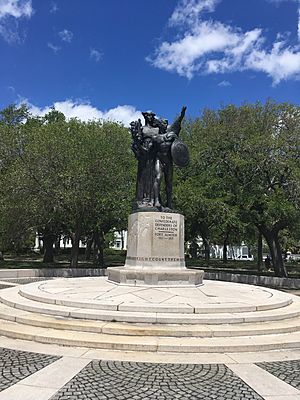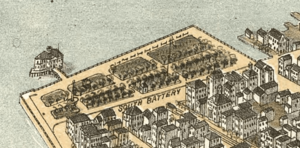White Point Garden facts for kids
Quick facts for kids White Point Garden |
|
|---|---|
| Location | 2 Murray Blvd. |
| Area | 5.7 acres (2.3 ha) |
| Created | 1800s |
| Operated by | City of Charleston |
White Point Garden is a cool public park in Charleston, South Carolina. It's right at the very tip of the Charleston peninsula. This 5.7-acre park is where the famous Battery seawall ends. It's surrounded by streets like East Battery, Murray Blvd., King St., and South Battery.
Contents
Park History
This area was once called South Bay or Oyster Point. In the early 1800s, it became known as White Point. Later, land was added to make the peninsula's tip sharper.
From about 1840 to 1881, a public bathing house stood at the end of King Street. This building was very expensive to build. It even had a cake and ice cream shop on its top floor! Storms damaged the bathing house several times, but it was always rebuilt. It was finally removed in 1881 as White Point Garden was made larger.
Park Features
For over 100 years, White Point Garden has been a place for important historical items and memorials. Many of these items are related to military history.
Military Relics and Cannons
In 1897, the city of Charleston asked the U.S. government for cannons that were left at Fort Sumter after the American Civil War. The government agreed to loan ten cannons to Charleston. Some of these cannons were put on display in White Point Garden in 1900.
You can find many military relics placed around the park. Along East Battery, there's an 11-inch Dahlgren gun from the USS Keokuk. This gun fired shells at Fort Sumter in 1863. There are also two Confederate columbiads, which are large cannons, used to defend Fort Sumter.
On Murray Blvd., you'll see more artillery pieces. These include a rare 7-inch Brooke rifle (another large cannon) found at Fort Johnson. There are also four huge 13-inch Union mortars, each weighing 17,000 pounds!
On the King Street side, there's a World War I howitzer from 1918. You can also see a French cannon from the American Revolutionary War. It was found in Camden, South Carolina. Plus, there's a fast-firing gun from a Spanish ship captured during the Spanish–American War.
Historic Monuments
White Point Garden is home to several important monuments.
Defenders of Fort Moultrie
Along the main path, you'll find The Defenders of Fort Moultrie monument. It honors the South Carolina soldiers who fought in the Battle of Sullivan's Island. This monument is often called the Jasper Monument. It features a statue of Sergeant William Jasper, a hero from the Revolutionary War battle won by the colonists at Fort Moultrie on June 28, 1776. The memorial was added in 1877.

Pirate Monument
At the northeast corner of the park, there's a marker for the "Gentleman Pirate" Stede Bonnet. This monument, put up in 1943, remembers the hanging of pirate captain Stede Bonnet and his crew in 1718. It also marks the hanging of Richard Worley's pirates in 1719. The monument says 29 of Bonnet's crew were executed nearby.
Confederate Defenders of Charleston

In the southeast corner of White Point Garden stands a large statue from 1932. It was placed there by the United Daughters of the Confederacy. This monument, called Confederate Defenders of Charleston, honors the soldiers who fought for their city and the Southern states during the Civil War. The bronze statue is 12 feet tall and stands on a 13-foot granite base.
USS Amberjack Memorial
Near the park's southwest corner, there's a memorial for the crew of the USS Amberjack. This submarine was lost during World War II. The memorial also remembers 51 other American submarines lost during that war.
Hobson Monument
Also near the southwest corner is the 20-foot tall, granite Hobson Monument. It remembers the U.S. destroyer Hobson. This ship was cut in half and sank in 1952 after crashing with an aircraft carrier. The stones in the monument's base come from the home states of the 176 sailors who died. The Hobson was built at the Charleston Naval Shipyard.
H.L. Hunley Memorial
At the meeting of Meeting Street and South Battery, you'll find a memorial to the crew of the H.L. Hunley. This granite monument, added in 1899, honors the first successful submarine. The Hunley sank in Charleston Harbor after a successful attack on the USS Housatonic.
William Gilmore Simms Bust
Along the park's central walkway, there's a bronze bust of William Gilmore Simms (1806-1870). He was a famous poet, novelist, and historian. His history of South Carolina was a key textbook for many years. The monument was added in 1879.
William Moultrie Statue
In 2007, a statue of William Moultrie was placed on the eastern edge of the park. This 8-foot statue shows Moultrie in uniform, holding his hat. He looks out over Charleston Harbor.
Bandstand
In the center of the park, across from Meeting Street, is a beautiful bandstand. It was started in 1906 and finished in 1907. This bandstand is a memorial to Mrs. George W. Williams from her daughter. It cost over $5,000 to build and used to host regular concerts. The first concert there was on June 28, 1907.
In 1978, concerts were stopped at the bandstand due to noise concerns. Even after a big restoration in 1985, concerts are still not allowed. However, the bandstand is used for weddings and special events. In 2010, the bandstand was restored again to its original height.
Dancing Girl Fountain
In 1962, a bronze statue of a dancing girl was added to the park. This statue was a gift to the city. It was designed as a water fountain with a low base so children could easily use it.






